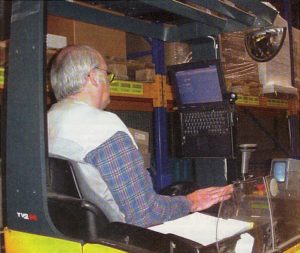Mobile data capture in warehouse management avoids a flood of paper
Dr. Bernd Reineke, Abels & Kemmner, Herzogenrath
An innovative electronics manufacturer has succeeded in reducing storage and retrieval processes by over 30 minutes and eliminating the flood of paper at the same time. What is remarkable is that the solution was implemented quickly and cost-effectively using simple technical and organizational means. The data acquisition was brought to mobile units exclusively with standard components and without customization programming.
Speed plays a particularly important role in the high-tech industry. This has an impact on all processes, but especially on logistics. A German electronics manufacturer was therefore looking for ways to simplify and speed up the storage and retrieval processes. The strategic lever was to avoid ways of obtaining and providing information, to make the flow of information as paperless as possible and at the same time to map the warehouse situation transparently and in real time.
However, such increases in warehouse efficiency often come at a high price: In addition to the special hardware required, the booking processes of the merchandise management and/or warehouse management system for the mobile units usually have to be reprogrammed at great expense. The results of the electronics manufacturer, which has brought data acquisition to mobile units using only standard components and without customization programming, show that there is another way.
To keep the effort as low as possible, SAP offers the option of the “SAP console”. Since the first reach truck has been working as a pilot truck with the mobile radio data transmission solution, the process in the 3800 Euro pallet spaces and 5000 square meter warehouse has been greatly simplified. Each storage unit of the products to be stored is labeled with its transport order number as a barcode. During storage, the forklift driver scans this code directly at the designated storage location. A handheld radio scanner records this data and forwards it to a notebook attached to the forklift truck (Figures 1 and 2). The notebook is connected online to the SAP system. There, the transfer order is confirmed directly in the SAP Warehouse Management (WM) module, completing the putaway and making the goods freely available. As the SAP system starts directly with the feedback interface when the forklift driver logs on, no keyboard input is required for this process and therefore no investment in touchscreens or other hardware components is necessary.
Detailed concept developed
 The idea for this mobile radio data transmission solution with cost-effective standard components arose during the introduction of the SAP system. However, before the technology could be used, a detailed concept was required, which was developed in collaboration with Abels & Kemmner. To this end, the processes were analyzed and the specific requirements identified. Based on this, the future processes were developed and the flow of materials and information was optimized. This resulted in the requirement to record the information at the point where it is generated. This included receiving the WM transport orders and acknowledging them immediately after execution. This is where a lot of time could be saved compared to before, when the transport order still had to be brought back to the warehouse office and reported back on paper. This wasted valuable time until the goods were ready for delivery or assembly.
The idea for this mobile radio data transmission solution with cost-effective standard components arose during the introduction of the SAP system. However, before the technology could be used, a detailed concept was required, which was developed in collaboration with Abels & Kemmner. To this end, the processes were analyzed and the specific requirements identified. Based on this, the future processes were developed and the flow of materials and information was optimized. This resulted in the requirement to record the information at the point where it is generated. This included receiving the WM transport orders and acknowledging them immediately after execution. This is where a lot of time could be saved compared to before, when the transport order still had to be brought back to the warehouse office and reported back on paper. This wasted valuable time until the goods were ready for delivery or assembly.
Although the required masks are available as standard in the R/3 system, the options for mobile data entry are limited. The aim was therefore to bring the SAP interfaces for internal transport control and feedback of transport orders to the forklift.
Simple but efficient
There was still a lot of homework to do before the time came. Even though standard components were to be used for the wireless connection, there was no standard configuration that also included the power supply for the components. As part of the introduction of warehouse management, it was necessary to clarify how the technical solution could be optimally integrated into the process. It was investigated which notebooks could be used, how they could be sensibly mounted on the forklift, which scanners were suitable and how the power supply could be most cleverly regulated.
First, a suitable notebook holder was designed for the pilot forklift. This metal charger has been tailored precisely to the standard notebook used. In the second step, pre-selected wireless scanner models had to undergo several tests until the right device matching the interface of the notebook was found. Finally, together with the forklift manufacturer, a solution with a voltage transformer was designed and implemented for the power supply to the devices.
Once the technical requirements for the forklift truck had been met, the next step was to set up the radio connection. The IT department experimented with the accessibility of the new wireless solution. The system was configured and tested again and again until the voltage and range were finally right. The effort was worth it: the base stations, i.e. the access points, transmit within a radius of 30 meters, and even up to 400 meters outdoors. The three base stations in the warehouse are set up so that their areas of activity overlap. This means that while the pilot forklift truck crosses the warehouse, it remains constantly connected to the SAP system online. It does not matter which access point it is currently in contact with.
The test phase for the mobile wireless data solution was completed after one month. The pilot solution has proven to be stable and safe. Any fears that the forklift system would cause vibrations that would affect the hard disk technology of the notebooks did not materialize. The standard technology also coped well with the vibrations. It was therefore decided to retrofit the three remaining reach trucks with the accessories.

Outlook
The next stage of expansion will be to scan the storage bin number during storage and check that it is correct. This prevents storage errors, e.g. in the wrong aisle or on the wrong level, and further reduces internal costs.
The results
With the wireless connection, the storage and retrieval processes could be shortened by 30 to 50 minutes, important time when it is often a matter of delivering on the same day. But the solution presented also had other advantages: Since the familiar SAP interfaces were used, no training was required for the warehouse employees. In addition to the necessary booking and information masks, the complete SAP functionality is available on the forklift. This offers considerable simplification in order to bring about clarifications at short notice or to simplify stocktaking with this solution. Ultimately, there was no need to build up any expertise in IT for programming proprietary PDC solutions; the available SAP know-how was completely sufficient. In addition, the wireless connection pilot project not only increased efficiency, but also improved data security in the warehouse when storing and retrieving goods.

